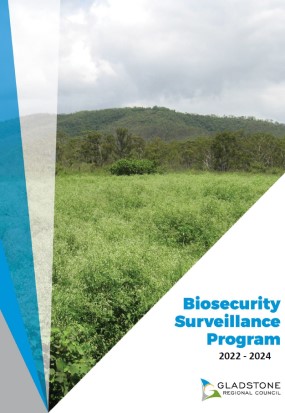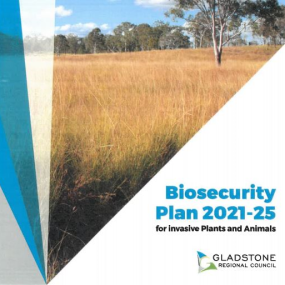Living Here
- Pets and Animals
- Residents
- Report
- Environment
- BackEnvironment
- Air Quality
- Biodiversity
- Biosecurity
- Blue-green algae blooms
- Bushfire Mitigation
- Coasts and Coastal Vegetation
- CoastSnap
- Conservation Programs and Initiatives
- Erosion and Sediment Control
- Feral Animals
- First Nations Fire and Land Officer
- Landfill Gas Abatement
- Mosquitoes
- Pests and Weeds
- Weed Spray Equipment Hire
- Wildlife
- Community Development
- Community Investment
- Services
- Emergencies
Emergency animal disease preparedness
Information and resources are available from Department of Agriculture and Fisheries to prevent and prepare for emergency animal diseases, including:
- Lumpy skin disease (LSD)
- Foot-and-mouth disease (FMD)
- African swine fever (ASF).
These have the potential to cause significant and far-reaching impacts to Australia’s livestock industries, including considerable economic losses and restrictions.
Make sure you:
- Follow Biosecurity Queensland on Facebook for updates
- Subscribe to DAF biosecurity alerts
- Learn about current biosecurity incidents across Australia.
What you can do to prepare
You know your animals best. Make sure you:
- Look for and know the signs of LSD (cattle and buffalo) FMD (cloven-hoofed animals) and ASF (pigs)
- Report suspected cases of emergency animal diseases to your veterinarian and the Emergency Animal Disease Watch Hotline on 1800 675 888 immediately
- Protect your livestock and livelihood by:
- having a biosecurity management plan in place
- ensuring your biosecurity entity registration details are up-to-date
- displaying biosecurity signage on your property
- using the Farm Check-In app when people visit your property.
What to do if there is an outbreak
Visit the Animal Health Australia website to understand the steps taken if there is an outbreak of LSD, FMD or ASF.
Biosecurity Act 2014 - General Biosecurity Obligation
On 1 July 2016, the Biosecurity Act 2014 replaced the Land Protection (Pest and Stock Route Management) Act 2002 for legislating the management of pest species in Queensland. Landholders do not need to know about all biosecurity risks but are expected to know about those associated with land management activities.
Residents' general biosecurity obligation means they need to ensure their activities do not spread a pest, disease or contaminant. Outlined below are the responsibilities that landholders are responsible for in relation to managing pest species within the Gladstone Region.
- Take all reasonable and practical steps to prevent or minimise each biosecurity risk
- Minimise the likelihood of the risk causing a biosecurity event and limit the consequences of such an event
- Prevent or minimise the adverse effects the risk could have and refrain from doing anything that might exacerbate the adverse effects.
Biosecurity Surveillance Program
Biosecurity Plan 2021 - 2025
Following community consultation Gladstone Regional Council has developed a Biosecurity Plan to strengthen and protect the Gladstone Region’s environment and ecosystems from biosecurity risks. In accordance with the Biosecurity Act 2014, the new strategy replaces the old Biosecurity Plan which expired in December 2020.
The new Biosecurity plan sets out key objectives and priority actions for our unique region. Key issues include invasive pest plants including giant rats tail grass, parthenium, feral Leucaena, absentee landholders and pest animals including wild dogs, feral pigs, rabbits, foxes, Indian myna birds.
The plan has been informed by community engagement and input, research, alignment with the Biosecurity Act 2014, and consideration of emerging priorities. It also forms the foundation of Council actions which includes control of land, community education & awareness and compliance & enforcement of the act within the region.
Thank you, to those who participated, for having your say on the Biosecurity Plan 2021-2025.
Council values your feedback and has used it to shape the new plan.
Key community feedback incorporated into the plan includes:
- The Gladstone Region community highlighted African Tulip trees and Tilapia fish as ongoing concerns. These have remained as containment species to ensure stakeholders are actively working on control and reduction.
- Among the significant environmental areas, the community highlighted waterways, national parks and conservation areas. These areas will help Council to focus and continue compliance and education.
- The community identified national parks, large and absentee landholders as priorities for compliance. This plan continues to support the education and awareness as a big focus and will retail the compliance and enforcement function too.
For more information go to conversations.gladstone.qld.gov.au/.
Surveillance Program
During a General Council Meeting on 7 June 2022, Gladstone Regional Council resolved to implement an invasive species surveillance program under the Biosecurity Act 2014 (Qld) commencing on 1 July 2022 to 31 May 2024.
This aims to:
- confirm the presence, or finding out the extent of the presence, of African Tulip Tree, Bellyache Bush, Giant Rat’s Tail Grass, Groundsel Bush, Harrisia Cactus, Mesquite, Parkinsonia, Parthenium, Prickly Acacia, Prickly Pear Spp., Rubber Vine; and
- monitor landholder compliance with requirements about prohibited matter or restricted matter.
A copy of the Surveillance Program is available for inspection or purchase, free of charge, at any Council Office or Rural Transaction Centre until the end of the program.
If you have any questions regarding the surveillance program, please contact Council's Biosecurity and Environmental Health team on (07) 4970 0700.
Catchment Working Groups
Gladstone Regional Council supports the establishment of Community Catchment Working Groups throughout the region to provide information and advice on pest management topics.
If residents are interested in establishing a catchment working group, please contact Council, who can provide further information and assistance.
The following Catchment Working Groups are currently active within the region:
- Boyne Valley Catchment Working Group - Coordinated by Capricornia Catchments
- Miriam Vale Rural Science & Landcare Society - Not coordinated by Council.
Giant Rat’s Tail Grass
Giant Rat’s Tail grass (Sporobolus pyramidalis and Sporobolus natalensis) are category 3 restricted invasive plants under the Biosecurity Act 2014 and listed as a ‘containment’ species under the Council’s Biosecurity Plan 2021-25.
Giant Rat’s Tail (GRT) grass can reduce pasture productivity, out-compete desirable pasture grasses and cause significant degradation of natural areas.
GRT grass seeds can spread quickly via livestock or by sticking onto vehicles and machinery and, once matured, is unpalatable to cattle, leading to health and productivity issues.
Under the general biosecurity obligation (GBO), property owners have the responsibility to take all reasonable and practical measures to minimise the biosecurity risk associated with invasive plants on their property.
The below education videos will provide advice for property owners in effective herbicide and management options for treating GRT infestations on their property.
Special thanks to Dr Wayne Vogler, Principal Scientist Biosecurity Queensland, Department of Agriculture and Fisheries.
Giant Rat’s Tail Community Forum
Biosecurity Queensland Department of Agriculture and Fisheries (DAF), in collaboration with Gladstone Regional Council, has concluded a five year research program to establish best practices for the management of Giant Rat’s Tail grass.
This invasive grass species reduces pasture productivity, out-competes desirable pasture grasses, can lead to heath issues when eaten by cattle and causes significant degradation of natural areas.
DAF Principal Scientist Wayne Vogler presented the study’s results, common infestation scenarios, ecology, effective herbicides, use of fire and pasture management at a Community Forum in May 2023.
African tulip tree removal program
Gladstone Regional Council is focused on maintaining and enhancing the region’s natural ecosystems while maintaining a healthy environment and productive agricultural systems.
The African tulip tree (Spathodea campanulata) is a category 3 restricted invasive plant under the Biosecurity Act 2014 and listed as a ‘containment’ species under the Council's Biosecurity Plan 2021-25. It has been identified on both Council land and private properties throughout the region.
Concerns include its flowers being toxic to native insects including the native stingless bees and its invasive growth pattern, crowding out native vegetation.
In recognition of community values, Council is committed to removing these trees from Council controlled land and will then work with landholders to assist with the control and follow up actions for the removal of this invasive weed on their property.
The program’s aim is to reduce and eventually eradicate it from the Gladstone Region.
Council has removed approximately 127 African tulip trees from Council land across six location zones:
- Zone 1 – Agnes Water, Bororen, Turkey Beach, Miriam Vale, Benaraby
- Zone 2 – Boyne Island, Tannum Sands
- Zone 3 – Barney Point, Sun Valley, Telina, Toolooa, Kin Kora
- Zone 4 – New Auckland
- Zone 5 – Gladstone Central, South Gladstone, West Gladstone
- Zone 6 – Callemondah, Clinton
The removal from Council land was completed in mid December 2021.
Living Here
- Pets and Animals
- Residents
- Report
- Environment
- BackEnvironment
- Air Quality
- Biodiversity
- Biosecurity
- Blue-green algae blooms
- Bushfire Mitigation
- Coasts and Coastal Vegetation
- CoastSnap
- Conservation Programs and Initiatives
- Erosion and Sediment Control
- Feral Animals
- First Nations Fire and Land Officer
- Landfill Gas Abatement
- Mosquitoes
- Pests and Weeds
- Weed Spray Equipment Hire
- Wildlife
- Community Development
- Community Investment
- Services
- Emergencies

Biosecurity Surveillance Program
The program will operate from 1 July 2022 to 31 May 2024
View documentGladstone Regional Council
Connect. Innovate. Diversify.
Get in Touch
Phone
(07) 4970 0700
Opening Hours
8.30am - 5pm Monday to Friday
Social media
Postal Address
PO Box 29, Gladstone Qld 4680
Council Offices
101 Goondoon Street, Gladstone Qld 4680
3 Don Cameron Drive, Calliope Qld 4680
41 Blomfield Street, Miriam Vale Qld 4677
Cnr Wyndham & Hayes Avenues, Boyne Island Qld 4680
Rural Transaction Centres
71 Springs Road, Agnes Water Qld 4677
47 Raglan Street, Mount Larcom Qld 4695
Footer Acknowledgement
Gladstone Regional Council would like to acknowledge the Bailai, the Gurang, the Gooreng Gooreng and the Taribelang Bunda people who are the traditional custodians of this land. Gladstone Regional Council would also like to pay respect to Elders both past, present and emerging, and extend that respect to other Aboriginal and Torres Strait Islander people. Learn more about Council's Reconciliation Action Plan (RAP).
Chat Popup
All content © Gladstone Regional Council. All Rights Reserved.
Back to the top








